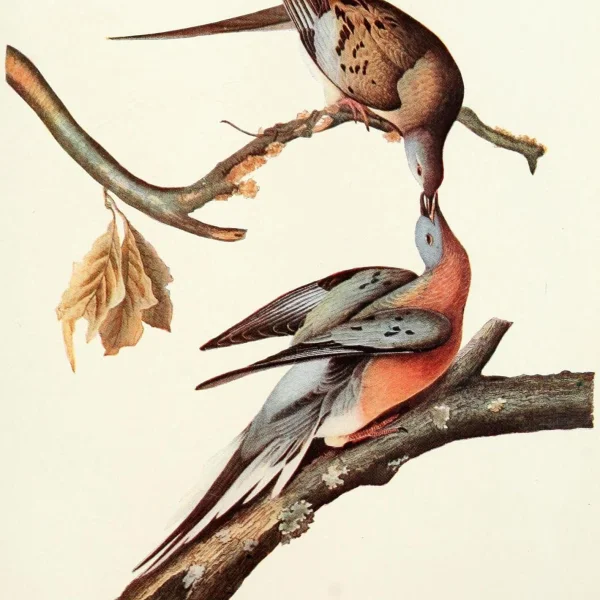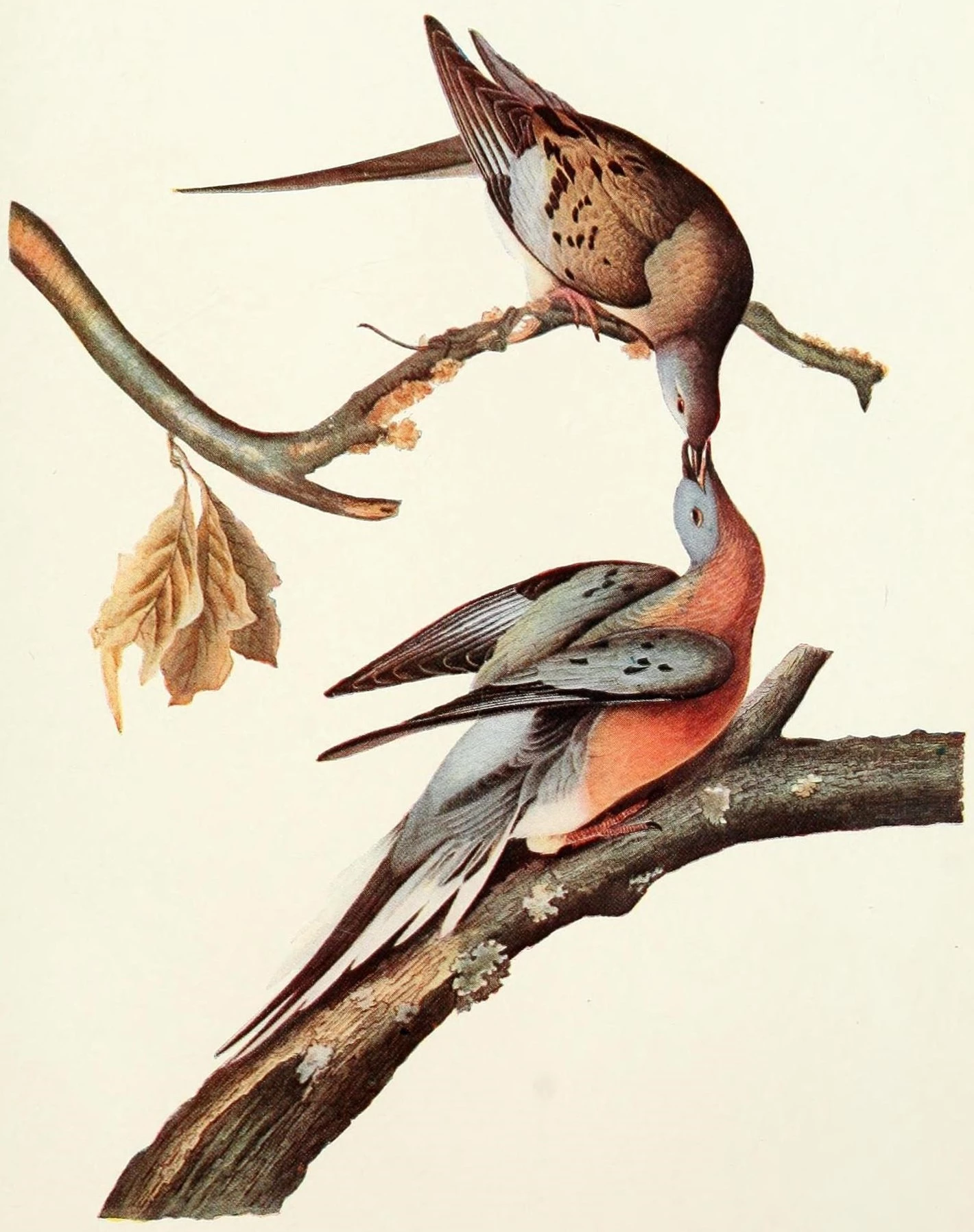In 1810, 24-year-old attorney Henry Marie Brackenridge traveled down the Ohio River to Ste. Genevieve, Mo. and what was still known as the French Illinois Country. Upon passing Louisville his party encountered the unrivalled natural spectacle of the passenger pigeon, once the most abundant bird on earth.
“In part of the river where the vision extended at least ten miles down … the whole heavens to the edge of the horizon were covered and concealed by a flight of wild pigeons and remained so for upwards of two hours,” Brackenridge later wrote. “During the whole day immense flocks continued to pass.”
Brackenridge, a reliable observer of the American frontier, estimated the size of the principal flock at 10 miles wide and 120 miles in length. This staggering account was no exaggeration, squaring as it does with many such 19th century observations, including those of ornithologist James Audubon.
Passenger pigeons—which as late as the mid-19th century numbered in the billions—were found in the forests of North America’s eastern half. Although Central Illinois was mostly tallgrass prairie, the timber along its rivers and streams and in its scattered groves was enough to sustain, at times, prodigious numbers of these birds. In this part of the state they would appear in great abundance several weeks in the spring and then again in the fall.
William B. Carlock, born in 1842 in a log cabin about 12 miles northwest of Bloomington, recalled the “great flocks of wild pigeons” that would pass through McLean and Woodford counties in the spring. He also mentioned the communal pigeon stews and fries held by the early pioneers.
Rev. John W. Denning, the longtime minister of First Methodist Church of Normal, settled in the area as a young boy in 1849. “Wild pigeons were so numerous that, in their flights, they darkened the sun,” he said. “They congregated in such numbers at their roosting places that large branches were broken off the trees. People did not waste powder and shot on them in those days; they simply killed them by knocking them off their roosts with long poles.”
A network of railroads began linking Central Illinois communities in the early 1850s, speeding the demise of the passenger pigeon. Railroads gave hunters the means to travel considerable distances to the site of large roosting colonies. And with railroads came the telegraph and the ability to make known the location of colonies to interested parties both far and wide.
These twin revolutions in transportation and communication made possible a rapacious, unsustainable exploitation of what was, after all, a limited resource. Hunters interested in passenger pigeons for market or sport, along with families and sometimes whole communities, would congregate under the colonies with traps, nets, poles, firearms and whatever else would further the slaughter. The scale of violence entailed in these large-scale “harvesting” operations remains shocking, even to those well-versed in the blood-soaked history of the Euro-American advance across the continent.
Even more tragically, the nestlings were highly desired by hunters for their tender meat. This selective targeting decimated successive generations of squabs and contributed greatly to the subsequent population crash.
McLean County resident E.L. Rodman remembered “wild pigeons beyond number” in the 1850s and 1860s. He said that Thomas Bolby, who lived in Old Town Township east of Bloomington, would use a “stool pigeon” [or decoy] and net thousands of birds at a time. “He would take them to Bloomington by half-wagon box loads and I think that one load would have been sufficient to supply one [bird] to each person in the town, for it was not a large place then,” noted Rodman in a 1922 reminiscence.
As if this wanton slaughter wasn’t enough, hundreds of thousands of pigeons were taken captive so sportsmen could organize shooting contests using live birds.
“A pigeon shoot will come off LeRoy Friday this week,” reported the Apr. 20, 1875 Pantagraph. “Five hundred wild pigeons have been secured, and a good time may be expected. Lovers of the sport are invited.”
In early October of that same year, the Bloomington Shooting Club received 2,000 live passenger pigeons for a two-day program at the old west side fairgrounds. The carnage included “world-renowned exhibition shot” Adam H. Bogardus killing fifty birds in eight minutes, all the while loading his own gun. “This will be by far the largest shooting tournament in Illinois this year,” boasted The Pantagraph, “and nearly all the best shots in the West will participate.”
The slaughter in Illinois continued into the 1880s, at least in the larger forested sections of the state where the bird could still be found in sufficient numbers. “Hunters report immense quantities of wild pigeons around Havana [Ill.],” noted the March 15, 1882 Pantagraph. “One man got 900 in one day, and killed as high as twenty at a single shot.”
By the mid-1890s, the days when the millions upon millions of passenger pigeons passed through Illinois were gone, never to return. “Wild pigeons are rapidly becoming extinct in this country,” reported the Nov. 13, 1895 Pantagraph. “They made biennial visits to this locality several years ago in large numbers, but have been decreasing in numbers each year of late until very few of these birds are ever seen here now.”
Twenty short years later wild pigeons had disappeared from not only Illinois but from the entire North American continent as well. “Martha,” the last known passenger pigeon, died at the Cincinnati Zoo on Sept. 1, 1914. “From billions to none in less than a century,” it was said of this appalling tragedy.
There are passenger pigeon taxidermy mounts and specimens in universities, museum and various research institutions in the U.S. and elsewhere. The John Wesley Powell-Dale Birkenholz Natural History Collections at Illinois State University include three “stuffed” pigeons, two of which are mounted. The third, a “study skin,” is dated May 26, 1877, and originated from Warsaw, Ill., a Hancock County community along the Mississippi River. The two mounted pigeons came from R.H. Holder, a Bloomington resident and amateur ornithologist.
Back in the fall of 1914, word of Martha’s passing was cause for somber reflection among some in Central Illinois.
“There is a touch of sadness in this announcement to those who still remember the millions of these beautiful birds that used to sweep in migratory flight across this country,” reflected The Pantagraph. “Every man who was a boy in those days can still picture to himself the long extended and graceful lines in which they moved, column after column, for hours and even days.”

